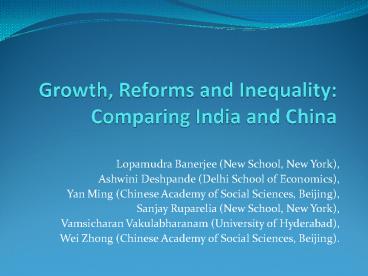Growth, Reforms and Inequality: Comparing India and China - PowerPoint PPT Presentation
Title:
Growth, Reforms and Inequality: Comparing India and China
Description:
Lopamudra Banerjee (New School, New York), Ashwini Deshpande (Delhi School of Economics), Yan Ming (Chinese Academy of Social Sciences, Beijing), – PowerPoint PPT presentation
Number of Views:72
Avg rating:3.0/5.0
Title: Growth, Reforms and Inequality: Comparing India and China
1
Growth, Reforms and Inequality Comparing India
and China
- Lopamudra Banerjee (New School, New York),
- Ashwini Deshpande (Delhi School of Economics),
- Yan Ming (Chinese Academy of Social Sciences,
Beijing), - Sanjay Ruparelia (New School, New York),
- Vamsicharan Vakulabharanam (University of
Hyderabad), - Wei Zhong (Chinese Academy of Social Sciences,
Beijing).
2
Our estimates for India
- Based on three NSS large surveys 1987-88,
1993-94 and 2004-05. - Variable used monthly per capita expenditure
(MPCE). Routinely used as a proxy for income,
since income figures are unreliable. - Overall trend is of rising inequality (Gini),
more in the second period (93-94 to 04-05 0.33
to 0.36)
3
Results contd.
- India rural mild decrease in the first period
(0.3 to 0.29), mild increase in the second period
to 0.3 overall more or less unchanged. - The aggregate Gini masks underlying changes.
- China sharper rise over a shorter period (upto
2002) 0.29 to 0.38. - Urban India 0.35 to 0.34 to 0.38
- China 0.30 to 0.33
- Urban inequality in China is lower than rural.
4
Explanations
- The agrarian sector in India has seen a
deceleration in the rate of growth -gt stagnation. - Slower rate of growth than total GDP increase in
inequality - Population in agriculture 60
- Share of agriculture in GDP 15
- High r.o.g. in sectors which have not created
enough employment (e.g. IT sector) bulk of
increase in employment in informal sector.
5
Explanations.
- Bulk of the Indian growth story is investment and
export driven. - Consumption has kept pace with overall growth.
- However, growth in consumption is driven by the
demands of the upper middle class and the rich
owners, managers, professionals growth of luxury
consumption. Investment is responding to this
demand.
6
Explanations..
- Inter-state variations federalism argument
liberalisation from above ? vertical
competition (between states for resources from
the centre) replaced by horizontal competition
(for private investment and FDI) provincial
Darwinism not all states are able to compete
successfully. States like Bihar, Jharkhand,
Tripura and Sikkim have negative real MPCE
growth. - Consumption of the urban middle classes elite
consensus on creating world class urban spaces
that celebrate the culture of capitalism.
7
Decomposition of Inequality
8
China
9
China Rural versus urban
10
Decomposition by R-U
11
Decomposition by Regions
12
China
- At the macro level, proportion of consumption in
GDP is declining. - Reason share of wage income is declining,
compared to the share of profit income. - Urban-rural divide increases TOT worsen
- Rural-urban migration was expected to reduce gaps
but migrants concentrated at the lower end of the
urban labor market, so gaps do not lower. - Social exclusion related to labour market
segregation hukou prevents economic and social
mobility
13
China
- Employment growth in China has been in formal
sector (as compared to India), but has mainly
been at the lower end. - Regional differentiation strongly related to the
open door policy adopted since the early 1990s.
Marked increase in coastal- inland inequality. - Role of the state introducing market-oriented
reforms gt initial increase in inequality since
1990s inequalities due to power access to
power abuse of power corruption state
monopolies. - Low wage jobs state preventing the emergence of
collective bargaining.
14
Social differentiation in China
- Private entrepreneurs new and expanding group
contributes a significant proportion to GDP,
provides employment. - The poor especially new urban poor, floating
population low wages, lack of access to
subsidized public service and face social
discrimination. - Changing social composition of the power
structure of the political regime increasing
political influence of the rich.
15
Comparisons
- Absolute levels and growth rates of income and
consumption in China much higher. - Story of rising inequality in the post-reform
period in both countries rise in China much
sharper than in India over a comparable period. - Rural urban gaps in China sharper.
- Rural-Urban decompositions the between
component in China is much higher. - Decomposition by region between component in
China higher than in India.































